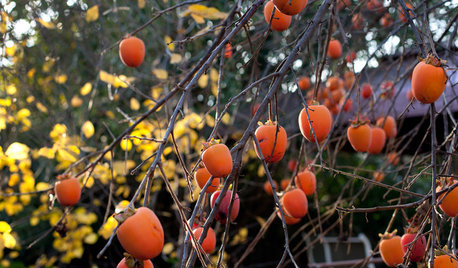What are your favorite American persimmon cultivars? (taste-wise)
Hi,
Thanks to Dennis, from Michigan (denninmi)(cultivar: 'Meader'), and finding a few wild growing specimens in the woods, I finally got to find out how American persimmon (Diospyros virginiana) tastes. I was impressed, particularly with the 'Meader' (at least) over the wild, smaller ones I found in the woods in the late fall.
I've been reading, essentially, every single article I can find that refers to common American persimmon cultivars and most of the information found online seems to be unoriginal, coming from a small hand-full of original opinions, mostly completely senseless in terms of distinction: i.e. one cultivar is said to be "very sweet", whereas another "taste: excellent", and yet another "delicious". So, basically the comparisons between cultivars found online are nearly invalid.
I found personal testimonies on this site of greater value. According to these:
*Some find 'Meader' to retain a little astringency, even when ripe; this is confirmed by Lee Reich (who I later contacted to confirm his preference for 'Szukis').
*Some find 'Wabash' to be better then a number of popular cultivars, consistent with one site which states this cultivar is sweeter then Garretson.
*Some find 'Szukis' (cf: Reich, et al) to be the best tasting.
*And there are other opinions on this and other forums...
So, please post your opinion comments being sure to list the different cultivars you've tried to show comparison.
Popular cultivars, supposedly chosen for taste: John Rick, Yates (Juhl), Szukis, Wabash, Garretson, Morris, Killen, Goldensupreme. I'd be curious to know about 'Prok', as it is said to be as large as 3" and originally found in NY state.
Comments (26)
njbiology
Original Author15 years agoHi Brandon,
I spoke to John at Nolin River (i'm going to order a 'Szukis' & 'Morris Burton', as well as 'Sunflower' & 'Wells' Pawpaw) - that place seems the place to order native persimmons.
John recommended the above 'Morris Burton' as the sweetest (according to many of his customers). According to a post by Lucky on this forum, 'Morris Burton' is considered one of the sweetest by reputation.
I'll go with those for now. How can I keep I maintain the trees (pruned) small, without greatly shortening its life - I have a feeling it will weaken the tree, maybe cause the trunk to mature with a bonsai effect (disproportionately large, expanded trunk). I'd like to keep them 10' max.
Related Professionals
Ashburn Landscape Architects & Landscape Designers · Kenmore Landscape Architects & Landscape Designers · Simi Valley Landscape Architects & Landscape Designers · Mount Wilson Landscape Architects & Landscape Designers · Aurora Landscape Contractors · Bristol Landscape Contractors · Cordele Landscape Contractors · Essex Landscape Contractors · Leicester Landscape Contractors · Mesa Landscape Contractors · Methuen Landscape Contractors · Red Oak Landscape Contractors · Thonotosassa Landscape Contractors · West Orange Landscape Contractors · Baileys Crossroads Landscape Contractorsshane11
15 years agoHi,
I have also been searching for american persimmon info for years and there is simply not a lot out there. Most info I have come across deals more with the asian type. I have the following planted but it will be several more years before they are all fruiting. Most of these I ordered from Nolin River, Hidden Springs, or Edible landscaping. 'Craggs', 'blue', 'early golden', 'john rick', 'meader', 'yates', 'ruby', 'morris burton', 'golden supreme', 'pipher', 'evelyn', 'szukis', 'miller', 'dollywood', and 'wabash'. I will be glad to give you my opinion on these as I am able. A few of these have fruited for me within the last couple years including 'yates', 'meader', 'john rick', 'ruby', 'blue', and 'early golden'. So far I havent been able to tell a lot of difference in flavor with all of these being very good. Yates is the earliest to ripen and most productive to date with very large and firm fruit. Meader seems to be the sweetest. Blue and ruby are late ripening. Blue has soft prune shaped fruit and not nearly as productive as my yates of the same age and size. Ruby has very large fruit. If I had to choose only one of these producing it would be yates for its large/firm sized fruit and its being very productive.njbiology
Original Author15 years agoHi Shane,
I see you're a big American persimmon enthusiast like myself - it's hard to find many that are, so I'm really glad to hear from you on this.
Firstly, I can tell you that many people, including Jerry Lehman, say that 'Meader' is not very good, and I think Lucy Pittman said that too. However, like yourself, a few say it is very sweet. I'm particularly curious about 'Meader' because the only ones I tried were the over-ripe ones that I tried this year, as well as 2 that were perhaps not ripe enough; and also because I heard that it remains slightly astringent, even when ripe, as compared to other cultivars. I really hope that this is not the case as, if this is true, there would be a risk, over time, of developing a serious gastro illness, the result of consuming the compounds that cause the astringency. So, please let me know if, when fully ripe, you've found 'Meader' to loose ALL of its residual astringency. I have a feeling that those who say it remains slightly astringent just haven't allowed the fruit to ripen well-enough.
Some opinions are as follows: John Brittain (Nolin Ridge, from whom I am ordering a number of cultivars and of pawpaws) told me that he believes 'Morris Burton' to be the sweetest, as his customers tell him and he feels it is, in his opinion, extremely sweet. Other sources indicate it as the 'sweetest'.
Lee Reich prefers 'Szukis' (at least from what I remember of our correspondence - either prefers it over all others or really likes it) and, as mentioned about, Jerry Lehman feels that 'Early Golden' is among the very best but doesn't regard 'Meader' highly.
So, since you've tried some of those varieties in comparison to 'Meader', i'll take your word... I was about to get rid of my small 'Meader' (produced 5 fruits last year).
I ordered (from John Brittain): 'Szukis' and I hope to get, if he has any left, 'Morris Burton' - or else I have to wait until the following year. I'm going to order 'Early Golden' (he's sold out and I'll find a good source, I hope). I was about to order the very large 'Prok' tonight until you told me you like 'Meader'. I thought 'Prok' would be a particularly good choice (as I needed a total of 4) because of its large size (almost 3"), but since I'd have 4 trees, I don't think that I need the fruit to be large, just sweet - and if 'Prok' is not sweeter then 'Meader', for instance, I would just stick with what I have.
I'm going to grow all 4 persimmons in the same hole, 8" apart so that they grow as a single, unified tree, expected the trunks to bond. I think the group will grow to a collective diameter of 28' at full maturity.
shane11
15 years agoI have not found "ripe" meader to have any astringancy. I always wait till they drop from the tree or come loose very easily from the tree with light touching. It ripens early in my climate. I remember Jerry saying that he did not like meader but didnt remember why. I suppose climate might play a role. Feel free to email me at derek_morris@ncsu.edu
lucky_p
15 years agoI have, or have had, at one time, 30+ varieties grafted & growing here, but not all have survived, and only a few have fruited, so my experience is limited. Between the EBFD of 2007, twig girdlers, marauding deer, and my neglectful managment style, just about any fruit/nut tree has to be tough and vigorous to make it around here.
Yates is very good - and it's a very large fruit for D.v.
NC-10 was tops in my orchard last year - but it was the only D.v. that fruited! Tasty, nonetheless, but it took 10-12 years to begin fruiting. Upright, almost timber-type growth.
Geneva Long, purported by some to be a hybrid, is NOT - and just an average D.v., as fruit quality is concerned. Bears nicely, and the fruit is good, but just average in size and quality.
I think Jerry L's main kick against Meader was that in the presence of male trees, it tends to overproduce(translates into smaller fruit size) very seedy fruits; fruit quality may be inferior to its Early Golden or Garretson(I forget which) parent.
There's a tree in a residential yard, up the street from my office that is probably EG or Meader; first fruits usually ripe around 20 Sept. - and most years, the fruit is very good, though each contains at least 5 seeds. Most years it bears so heavily that it snaps 1.5-2" branches off at the trunk. 2008 fruits were so small that they weren't worth bothering with - mostly seed.Wabash, which hasn't yet fruited for me, does, however, live up to its reputation for outstanding red/purple fall leaf color. I have another D.v. selection that I made from a roadside fencerow in central AL for great red fall color, but at this point, I don't know if it's a male or female.
Rosseyanka & Keener have been regular annual producers for me. Rosseyanka fruits are large, later-maturing, and more reminiscent of the D.kaki parent in character and flavor.
Keener, an alleged/disputed hybrid of D.kaki & D.virginiana, produces a large fruit resembling D.virginiana in appearance and flavor, but has more substance/fiber in the pulp than the typical D.v. or astringent-til-ripe D.kaki.jraymond
15 years agoIt's a tough call as so many of the new ones are so good, but I'd probably venture that my current favorite for eating out of hand is Prok. I also like Claypool C-100 which tastes just like Morris Burton (it's seed parent) to me except the fruit is larger, a little firmer, and more attractive. Some of the varieties bred by Claypool, Lehman, and Compton are just as good if not better. Too bad historical hold-overs like Meader still dominate the web chatter and nursery market.
As for size, Jerry Lehman has bred some very large ones using Claypool stock as seed parents. I saw his 100-47 last fall, and it was the largest native persimmon I've ever seen. As big as the Fuyu persimmons I buy from the local produce store - only they taste better in my book. I much prefer the flavor of a Virginiana to a Kaki although I still enjoy kaki, too.
I found a nice seedless one last fall at the Muscatatuck Wildlife Refuge. I must've eaten about thirty or so before rolling myself over to the truck. Luckily, I still had room for a six pack and some nachos when I got home.
Apparently the site I stumbled upon used to be a cultivated orchard of seedless persimmons discovered and propagated by a fellow named Carl Meyers. The whole area was later expropriated by the government back around the 60's to create the wildlife refuge, and the trees I came across were the last remnants of that orchard. Very good eating with clean pulp and skin - about an inch in diameter. Never came across a seed so I gobbled them like they were big grapes. I found some history on it in the book, Our Memories of Home, on http://books.google.com/ .
chills71
15 years agoI wanted to get one this year as well (actually I just decided recently to get one) and my research has brought me to the conclusion that szukis was the one I wanted too. The Claypool ones deem interesting, but lack of availability and fruit reviews makes them seem like a crap-shoot if they can be found at all.
My Ichi Ke Kei Jiro appears to have made it through another winter here in Michigan, maybe this will be the year I get it to fruit.
~Chills
creekweb
15 years agoI think that in assessing the quality of any fruit including the American persimmon I don't so much concentrate on an individual characteristic such as taste but more so on the overall desirability of the fruit. For persimmon this is dependent also on texture, size, seed percentage and even the durability of the skin. My gestalt of these qualities leaves me to choose the variety Prok as the the best I've tried. However, I don't believe that it does distinguish itself on the basis of flavor, though its flavor is good and without residual astringency. Some wild persimmons can have a somewhat medicinal or chemical quality to their flavor, but this is absent in the better varieties which instead are reminiscent of butterscotch or caramel. Prok's texture is one of the best, not at all mealy or pasty but somewhat akin to though less gelatinous than that of a good Asian persimmon like Hachiya. And the smooth plump seeds seem less of a detractor partly because of Prok's relatively large size and partly because they easily separate from the pulp.
Another variety I like is Osage which is an open-pollinated seedling of H69A, a Morris Burton/ Early Golden cross. This precociously bearing one is large and tasty with few seeds and easily loses its astringency on ripening.njbiology
Original Author15 years agoI wonder if, to save space, (since I have: Prok, Szukis, & Morris Burton), I should get rid of my Early Golden & Meader saplings.
If Early Golden & Meader turn out to be a fraction less desirable (taste-wise) then either Prok, Szukis, or Morris Burton, what would be the point of growing them (since I'd like to save the extra room)?
Could anyone here suggest some reason(s) that Early Golden and Meader are worth keeping for me, since I have the other three mentioned?
Szukis (i'm counting on) produces male flowers, so that offsets the otherwise added benefit of Early Golden providing some male flowers.
Steve
lucky_p
15 years agoSteve,
In taste tests at the Claypool persimmon orchard in IN, year-in/year-out Early Golden has come out as the preferred persimmon by the majority of taste-testers. I wouldn't remove it.njbiology
Original Author14 years agoHow could I get rare varieties like Meyer, Ennis, etc.
I don't think that Jerry Lehman of the Claypool orchard is able to sell or give-out scion wood, or else I'd get some of his. I'd like a wide variety of cultivars, and not just the ones available through a google search.
I don't know if it's possible.
Steve
appleman178
14 years agoI've eaten a small number of named varieties over the years, and my favorite changes each time I have a good one. A couple years ago Prok was my favorite, then Early Golden, and another year an unnamed variety that a friend in Eaton Rapids MI has. I've received scionwood from Jerry Lehman before, so that's not a problem. Members of the Northern Nut Growers and Michigan Nut Growers Association are also very gracious about exchanging scionwood. A few years ago Lucky sent me some stratified seeds and I have a row of about 25 now from those seeds. This Spring they were big enough to graft onto about half of them. So far, that row has Ennis Seedless, Early Golden, and Prok. Some time before next Spring I'll need to make some decisions about what other varieties are going on board, but they're all good.
alan haigh
14 years agoI'm not very knowledgeable about Amer. pers. but I do know that Lee Reich lives in a Z5. Early ripening is probably the most important trait in a pers where he is.
njbiology
Original Author14 years agoI'm definitely not getting rid of my Early Golden.
I have a feeling that Prok is the best (haven't yet tasted it).
Does anyone know where I can get some rare persimmon cultivar scion wood?
njbiology
Original Author14 years agoHi John,
How could someone obtain a 'Meyer' graft or scion wood?
100-47 sounds like it might be extremely popular if marketed.
Thanks,
Stevefrancis_eric
14 years agoIM also interested In persimmons, I don't have room here though,
but I think it would be great to grow some from seed to distribute In the wild.
since they are native, and it's possible they can grow in zone 5 or even zone 4.acually Im interested In anything thats native paw paw, hickory(but I can find some of those)
I have been killing off invasive species honey suckle shrubs , buckthron, tress along the bike trail,
even a bi annual garlic mustard kills off native plants by releasing toxins to kill off plants, and germinating seeds.I guess thats why Im asking for TONS OF seeds so I grow, some, and after establishing them, transplant them into the wild.
(IM also interested In breeding plants
Maybe in the fututre I can do more of that,
and at leasts be sucessful if it doesn't rain again)gonebananas_gw
14 years agoOurs in SC are different I believe from the ones they are discussing though. 60 chromosomes vs. 90, which of course we don't notice, but so many of ours are scraggely almost bushy trees on terrible to just marginal sand soils and theirs tend toward "real" trees on richer soils. I love our native ones, they can have a nice rich flavor, but I've never seen a very large fruit. They must exist here and there but I've never heard tell of it.
I've been meaning to ask whether the seedlings the SC Forestry Department sells come from southern (60) or northern (90) seed sources.
skyjs
13 years agoI tasted a Garretson persimmon a year and a half ago and I knew I had to go out and buy the tree. I like the regular species D.v. but the Garretson had so much more flavor! No fruit yet of course. I find the Asian varieties sweet but uninteresting. That's why I wonder if Morris Burton or the other varieties they describe as "extremely sweet" might not do it for me. The Garretson I tasted had a very complex, balanced taste. Sweet, yet so much more. Great texture, savory, everything. I'm still excited and I only tasted one a year and a half ago.
John S
PDX ORdfranz
13 years agoYates is my pick. For me, Meador fruited young and is productive and early each year, but it's inferior to Yates in every way. My property is overrun with wild persimmons. Those fruit are tiny, seedy, pasty and very astringent. Yates flowers well before all the other trees and has been reliably seedless while Meador has seeds. Prok, Morris Burton and Early Golden haven't fruited yet for me - munched on severely by deer.
Here is a link that might be useful: Yates pic
trevornewman
12 years agoI tried Prok this season from a friends orchard and I wasn't impressed by the flavor as it lacked over all character and sweetness. However the texture was nice compared to some of the other american persimmons i've tried, as well as the size. It was definitely more firm than others. I have heard from some sources that Prok has some asian in it, but I don't know if this is true. Here is a picture of one: http://www.flickr.com/photos/25212487@N04/6224647515/in/photostream
I also tried a claypool selection from another friends farm and again, compared to some of the other persimmons I've tried(which I'll explain next), it lacked over all flavor complexity. However it was sweeter than Prok. Here is a picture of that...unfortunately I don't remember the cultivar name, probably because it consisted of a few numbers and was easy to forget. Anyways, it was a claypool selection: http://www.flickr.com/photos/25212487@N04/6271281968/in/photostream
My best american persimmon experiences were all at Oikos Tree Crops in southwest, MI where I spent several months examining the american persimmons trees planted there. All of which are seedlings from good selections, i.e. yates, morris burton, etc. Ken Asmus has wonderful seedling planting with over 500 mature trees. There is incredible variation in fruit size, color, texture, flavor, and ripening time. Some don't even ripen in some years. We are working on developing a selection of cultivars from this planting that will be grafted and hopefully available in the nursery trade. These will be some of the northernmost american perisimmon selections, which is great for folks like me in MI where ripening can be a problem. One tree in particular was a seedling of Morris Burton and had AMAZINGLY delicious fruit with very high sugar content and a delectable flavor with butter scotchy notes..by far the sweetest I have ever tried. The flesh on this variety was a rich reddish color...very beautiful. Here is short video of it: http://www.youtube.com/watch?v=Iofe3u5pruY&list=UUsSu_6ip07ywsY37D35Cm8w&index=10&feature=plcp
Out of the seedling population we also found a tree that produces blue skinned fruit. And not just a touch of blue but very blue! Here is a nice picture of it: http://farm5.static.flickr.com/4083/5167939059_56e3a070e3_z.jpg
If you're in Michigan or a similar climate where ripening can be an issue I would consider planting some seedlings from Oikos Tree Crops if you have the space. Sorry I don't have more info about specific cultivars, will have more to come. Cheers!
milehighgirl
9 years agoI am reviving this thread because I found something very interesting in the post by jraymond:
"I found a nice seedless one last fall at the Muscatatuck Wildlife Refuge. I must've eaten about thirty or so before rolling myself over to the truck...Apparently the site I stumbled upon used to be a cultivated orchard of seedless persimmons discovered and propagated by a fellow named Carl Meyers.
Does anyone have any information about this site? It seems that it would be worthwhile for someone near there to take some scion.
creekweb
9 years agoSurprise early winner this year: Evelyn, scoring points largely on sweetness, but also on early ripening, decent size, confectionary consistency, good and early loss of astringency and lack of off-flavors. The flavor of this one is good though other persimmons have richer butterscotch. Odd, since Evelyn is one that in past years ripened late and would cling to its astringency. Osage and Morris Burton also good this year but small. Haven't had a Prok yet this year. Yates okay but the main crop still ripening. 100-46 smaller than usual though still my largest persimmon but the flavor is subpar with off-flavors. Szukis forgettable and small. I-97A small and so far not outstanding but the tree is still small so this abservation probably not worth much..
cousinfloyd
2 years agolast modified: 2 years agoCreekweb, I'm wondering what your favorite American persimmon varieties are now 7 years later.
Anyone else want to rank or score the varieties you've fruited?
Here's a list of most of the named varieties I've fruited so far, roughly in order from my favorite to least favorite: H118 (although this is very tentative, because I haven't gotten much fruit yet, but it seems like it might be about as tasty as Early Golden but with size comparable to the other very large varieties; it doesn't have the same really attractive reddish orange color of Early Golden, though), Early Golden, 100-46, Myers seedless, Prok, Ruby, Elmo, WS-8-10 (high scores for size and productivity but otherwise unimpressive), and then at the very bottom, Meader, which isn't bad but it doesn't come close to competing with any of the others, and I'm not sure I'd even rate it higher than the average wild tree.




















brandon7 TN_zone7